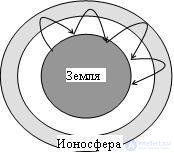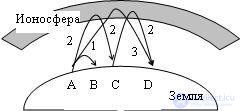Lecture
Radio waves with a wavelength of more than 1 kilometer have a distinctive feature - the ability to bend around the Earth well during its propagation. Therefore, waves in this part of the range are capable of propagating far beyond the line of sight. Of course, when the radiating antenna is removed beyond the horizon, the signal will be significantly weakened, but, in general, in this frequency range, a sufficiently confident connection can be provided at distances of hundreds and thousands of kilometers.
Radio waves that propagate along the surface of the Earth are called terrestrial or surface waves. In this frequency range, in addition to surface waves, spatial waves are also used for communication. Spatial (ionospheric, celestial) are those waves that, being emitted from the surface of the Earth, will be reflected from the ionosphere and return to Earth again. The propagation path of a spatial wave returning to Earth after reflection from the ionosphere is called a jump. Electromagnetic waves in the lower part of the radio range are also well reflected from the surface of the Earth (that is, with low losses). The radio waves reflected from the Earth upon reaching the ionosphere are re-reflected from its lower layers, forming the next jump.
Thus, a simplified model of the medium of propagation of long and superlong radio waves can be represented in the form of two electrically conductive spheres with combined centers. Radio waves propagate in the gap between these spheres, alternately reflecting from the external, then from the internal sphere. The earth, together with the lower boundary of the ionosphere, forms for this range a kind of spherical waveguide. In this waveguide, a multi-hop propagation path is formed (Figure 6.4).

Fig. 6.4 Propagation of long radio waves by spatial rays
The high stability of the propagation of radio waves of this range is used, for example, by radio transmitters of the exact frequency and time service, the signals of which are used in communication systems of all frequency ranges.
In conclusion, it should be noted about the features of the propagation of an electromagnetic collar *** lower than the lower part of the radio range. Since the magnitude of losses during the propagation of radio waves in a medium with losses (soil, water, ionized gases, etc.) decreases with increasing wavelength, the depth of penetration of radio waves into this medium increases with increasing wavelength. This feature of propagation of radio waves is used, for example, to communicate with submarines immersed to a depth of hundreds of meters from the ocean surface. For this (the only possible) type of radio communication, very low frequencies (very long waves) are used, which requires large antenna sizes and high power of radio transmitters.
Radio waves with a wavelength of 100 to 1000 meters, as well as longer ones, propagate both surface and spatial waves, but their propagation has its own characteristics. The influence of the instability of the parameters of the ionosphere on the propagation of radio waves of this range becomes more and more noticeable, and the length of the path traveled by the spatial wave to the reception point at different times of the year and day turns out to be different.
During the day, in this range of waves at distances up to several hundred kilometers, surface waves are used for communication. With an increase in the frequency of colloquies, a higher concentration of charged particles of the ionosphere is required for the formation of a reflected wave, with radio waves penetrating ever higher layers of the atmosphere. But with an increase in the length of the path traveled by the radio wave in the ionosphere, its losses increase. Radio waves of this range reach the E layer of the ionosphere and return to the Earth. During the day, the lower D layer has a high concentration and causes a significant attenuation of radio waves, therefore the spatial waves of this range are very weak.
At night, the communication range can be increased due to the fact that at night, layer D almost disappears. The attenuation of radio waves in the ionosphere is significantly reduced and the influence of the spatial wave in this range becomes more noticeable. In the end, this leads to the fact that at long distances at the receiving sites there may be a fading effect, or fading, manifested in a change in the level of the received signal. The main cause of signal fading is the interference of spatial and surface waves. Figure 6.5 shows conditional paths to a point far enough from the radiating antenna, surface radio wave 1 and spatial radio wave 2. Since the path length that radio waves travel can change constantly, the phases of the incoming signals also change continuously.

Fig. 6.5 Propagation of surface and spatial radio waves
The result of adding two signals of the same frequency, but with different phases, varies from the maximum value (when the phases of the incoming colossus *** match) to the minimum (when the phases of these signals are opposite). If the powers of the collisions coming from different directions are approximately the same, then the level of the received signal, formed as a result of interference, can drop to almost zero.
Near the transmitter, where mainly surface waves are present, the fading effect is practically absent. At large distances, where propagation of both spatial and surface waves is possible, at night the ligature can improve, but with significant fading. And at very large distances, where the Earth wave practically does not reach, the reception of a spatial wave is possible at night.
Radio waves with a wavelength from 10 to 100 meters also propagate in the form of spatial and surface waves, but as the frequency increases, the Earth's absorption of surface wave energy increases even more, and they weaken faster. Therefore, in the short-wave radio frequency range, the propagation of surface waves is limited almost to direct line of sight. Further extends a zone of silence, where it is impossible to confidently receive signals.
In the decameter wave range, a fading effect is also possible. It is also caused by interference, but by two or more spatial rays that arrive at a reception point in different ways.
Figure 6.6 shows the course of the rays of decameter waves emitted from point A. Waves in this range penetrate deeper into the ionosphere. The boundary of the propagation of terrestrial waves is indicated by point B. Spatial waves arrive at point C after the first reflection from the ionosphere. The belt of the earth's surface between points B and C forms a zone of silence. In this zone, the surface waves are already so weakened that they cannot be used for communication, and the waves reflected from the ionosphere reach the surface of the Earth at a much greater distance from the transmitter. At a further distance from the point of radiation A, the arrival of a wave after double reflection from the ionosphere is possible. If another spatial wave arrives at the same point of reception, for example, after a single reflection from the ionosphere, then at the point of reception D there is interference of signals and, as a result of it, fading during reception.

Fig. 6.6 Distribution of decameter radio waves
Radio waves, whose length is less than 10 meters, practically do not have diffraction, that is, they cannot bend around obstacles in the path of propagation. The concentration of charged particles in the ionosphere is insufficient to significantly influence the propagation path of radio waves of this range, therefore radio waves are practically not reflected from the ionosphere. On the one hand, this makes remote communication impossible on the surface of the Earth beyond direct line of sight, on the other hand, it allows using radio waves of this range for satellite communications.
Thus, the main characteristics of the propagation of electromagnetic collars *** of the ultrashort wave (VHF) range determine the possible connection in this range within the line of sight between the transmitting and receiving antennas. To increase the communication range, the antennas are mounted on high supports (Figure 6.7).

Fig. 6.7 Maximum communication range on ultrashort waves
The maximum communication distance DB (taking into account only the spherical shape of the Earth, without specifying the terrain) is determined by the heights of the transmitting and receiving antennas, respectively, h1 and h2, and the Earth radius RЗ:
 (6.4)
(6.4)
When using this empirical formula, the maximum line-of-sight distance DB and the Earth radius RЗ should be expressed in kilometers, and the antenna heights of h1 and h2 should be expressed in meters.
In this wavelength range, signal interference is also possible, but already with reflected signals from the Earth or other irregularities of the relief or structures. Figure 6.8 conventionally shows the course of the rays of a straight and reflected waves from the Earth’s surface.

Fig. 6.8 Propagation of direct and reflected waves of VHF
With a sufficiently high transmitter power, communication beyond the horizon is also possible in this wavelength range. Long-distance communication beyond the line of sight is possible due to the fact that local inhomogeneities may arise in the Earth’s atmosphere for a number of reasons. These irregularities and cause scattering of radio waves, including in the direction of the receiving point. With sufficient sensitivity of the receiving device, radio communication can be organized in remote areas at a distance of several hundred kilometers.
Figure 6.9 presents a diagram of a possible connection using radio wave scattering on atmospheric inhomogeneities.

Fig. 6.9 Scattering of radio waves from atmospheric inhomogeneities
Comments
To leave a comment
Devices for the reception and processing of radio signals, Transmission, reception and processing of signals
Terms: Devices for the reception and processing of radio signals, Transmission, reception and processing of signals